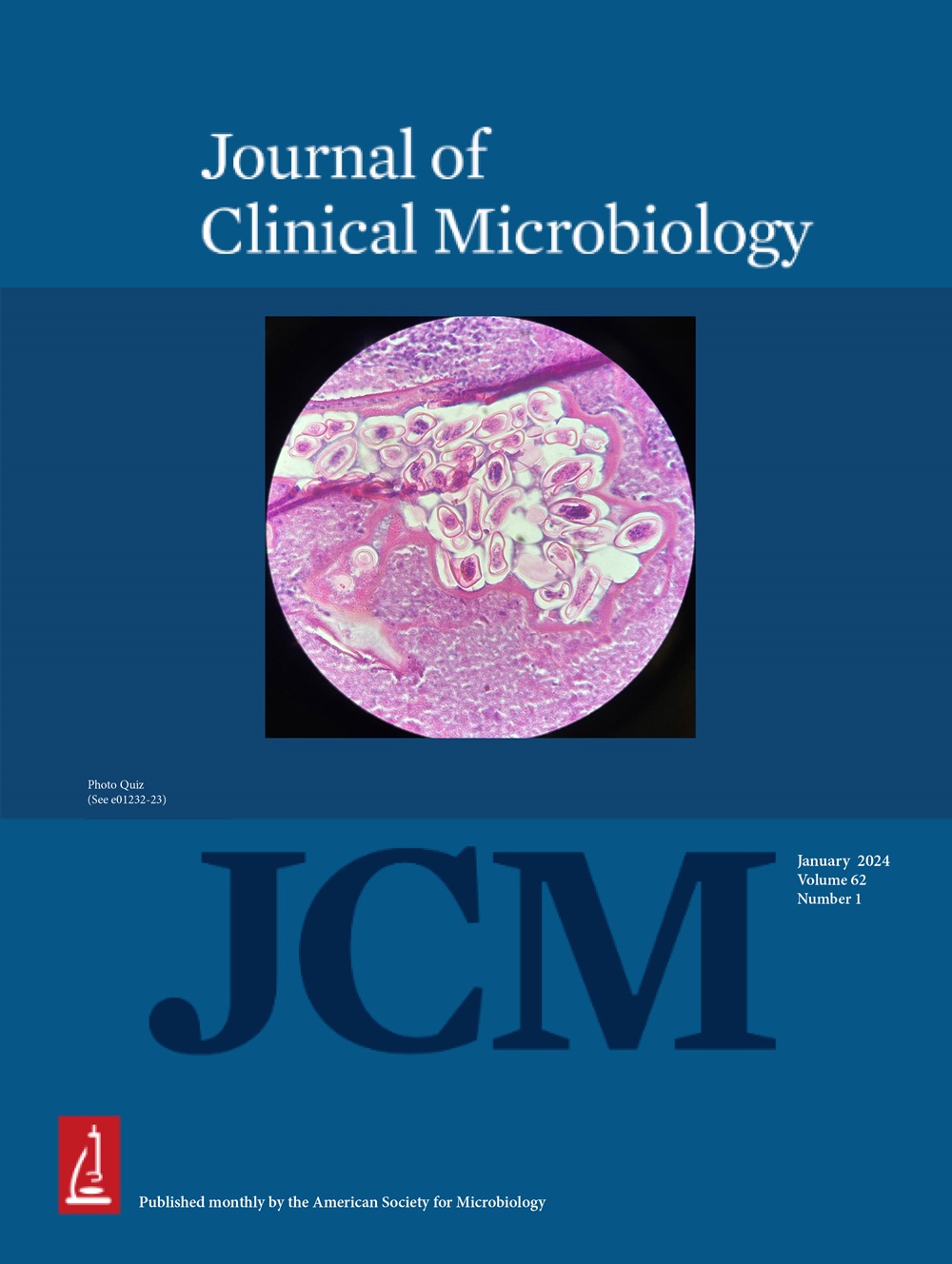用于检测和分类革兰氏阴性杆菌中主要的 A 类和 B 类碳青霉烯酶(包括双重生产者)的改进型蓝色卡巴检测法和卡巴 NP 检测法。
摘要
及时、准确地识别产碳青霉烯酶生物对于指导临床抗生素治疗和限制传播至关重要。在此,我们建议修改蓝色卡巴试验(BCT)和卡巴NP-直接试验(CNPd),通过添加特异性A类和B类抑制剂来鉴定分子碳青霉烯酶类别,包括双重碳青霉烯酶菌株。我们检测了 171 株产碳青霉烯酶的革兰氏阴性杆菌,其中 21 株属于 A 类(KPC、NMC、SME),58 株属于 B 类(IMP、VIM、NDM、SPM),92 株产双重碳青霉烯酶(KPC+NDM、KPC+IMP、KPC+VIM),所有这些菌株之前都用 BCT 或 CNPd 检测呈阳性。我们还纳入了 13 种不产生碳青霉烯酶的细菌。β-内酰胺酶之前已通过 PCR 鉴定。改进的 BCT/CNPd 方法使用 pH 指示剂和 A 类(阿维巴坦)和/或 B 类(乙二胺四乙酸)抑制剂检测亚胺培南-西司他丁溶液中的亚胺培南水解作用。检测结果根据颜色变化直观判读。CNPd 对碳青霉烯酶分类的灵敏度为 99.4%,特异性为 100%,而 BCT 的灵敏度为 91.8%,特异性为 100%。碳青霉烯酶类别不同,检测结果也不同:两种检测方法都能对所有 A 类产菌菌株进行分类。对于 B 类,CNP 检测可识别 57/58 株菌株(98.3%),而 BCT 检测可识别 45/58 株菌株(77.6%),其中非发酵菌株的检测难度最大。对于 A 类和 B 类双重生产者,两种检测方法的表现都非常出色,BCT 检测方法仅检测出一株不确定菌株。统计比较显示,两种方法得出阳性结果的时间相近,但因涉及的碳青霉烯酶类别或细菌群而有所不同。这种改进后的检测方法能在不到 2 小时的时间内快速区分革兰氏阴性杆菌中主要的 A 类或 B 类碳青霉烯酶生产者,包括双类组合:重要意义:快速、准确地鉴定碳青霉烯酶产生菌对指导适当的临床抗生素治疗和遏制其传播至关重要。在严重急性呼吸系统综合征冠状病毒 2 大流行期间和之后,出现了携带多种碳青霉烯酶组合的阴性杆菌,这给通常用于确定分离菌株中特定碳青霉烯酶类型的传统生化检验带来了挑战。有几项计划旨在改进比色法,使其能够独立识别 A 类或 B 类碳青霉烯酶的存在。值得注意的是,此前还没有人尝试过同时区分这两种类型。此外,这些改良方法也很难区分多种碳青霉烯酶的携带者,而这在许多拉美国家都很常见。在这项研究中,我们将特定的 A 类和 B 类碳青霉烯酶抑制剂引入蓝色卡巴试验(BCT)和卡巴 NP-直接(CNP)比色测定法中,以确定碳青霉烯酶的类型,即使在这些类别中存在多种碳青霉烯酶生产者的情况下也是如此。这些更新后的检测方法具有极高的灵敏度和特异性(≥ 90%),而且所有检测都能在 2 小时内快速完成,通常只需 45 分钟即可完成。这些对 BCT 和 CNP 检测方法的内部改进为确定主要碳青霉烯酶类别提供了一种快速、直接和经济有效的方法。它们可以作为分子生物学或免疫层析技术的可行替代方法,在整个过程中充当初始诊断步骤。Prompt and precise identification of carbapenemase-producing organisms is crucial for guiding clinical antibiotic treatments and limiting transmission. Here, we propose modifying the Blue Carba test (BCT) and Carba NP-direct (CNPd) to identify molecular carbapenemase classes, including dual carbapenemase strains, by adding specific Class A and Class B inhibitors. We tested 171 carbapenemase-producing Gram-negative bacilli strains-21 in Class A (KPC, NMC, SME), 58 in Class B (IMP, VIM, NDM, SPM), and 92 with dual carbapenemase production (KPC+NDM, KPC+IMP, KPC+VIM), all previously positive with BCT or CNPd. We also included 13 carbapenemase non-producers. β-lactamases were previously characterized by PCR. The improved BCT/CNPd methods detect imipenem hydrolysis from an imipenem-cilastatin solution, using pH indicators and Class A (avibactam) and/or Class B (EDTA) inhibitors. Results were interpreted visually based on color changes. CNPd achieved 99.4% sensitivity and 100% specificity in categorizing carbapenemases, while BCT had 91.8% sensitivity and 100% specificity. Performance varied by carbapenemase classes: both tests classified all Class A-producing strains. For Class B, the CNP test identified 57/58 strains (98.3%), whereas the BCT test, 45/58 strains (77.6%), with non-fermenters posing the greatest detection challenge. For Classes A plus B dual producers, both tests performed exceptionally well, with only one indeterminate strain for the BCT. The statistical comparison showed both methods had similar times to a positive result, with differences based on the carbapenemase class or bacterial group involved. This improved assay rapidly distinguishes major Class A or Class B carbapenemase producers among Gram-negative bacilli, including dual-class combinations, in less than 2 hours.
Importance: Rapid and accurate identification of carbapenemase-producing organisms is of vital importance in guiding appropriate clinical antibiotic treatments and curbing their transmission. The emergence of negative bacilli carrying multiple carbapenemase combinations during and after the severe acute respiratory syndrome coronavirus 2 pandemic has posed a challenge to the conventional biochemical tests typically used to determine the specific carbapenemase type in the isolated strains. Several initiatives have aimed to enhance colorimetric methods, enabling them to independently identify the presence of Class A or Class B carbapenemases. Notably, no previous efforts have been made to distinguish both classes simultaneously. Additionally, these modifications have struggled to differentiate between carriers of multiple carbapenemases, a common occurrence in many Latin American countries. In this study, we introduced specific Class A and Class B carbapenemase inhibitors into the Blue Carba test (BCT) and Carba NP-direct (CNP) colorimetric assays to identify the type of carbapenemase, even in cases of multiple carbapenemase producers within these classes. These updated assays demonstrated exceptional sensitivity and specificity (≥ 90%) all within a rapid turnaround time of under 2 hours, typically completed in just 45 minutes. These in-house enhancements to the BCT and CNP assays present a rapid, straightforward, and cost-effective approach to determining the primary carbapenemase classes. They could serve as a viable alternative to molecular biology or immuno-chromatography techniques, acting as an initial diagnostic step in the process.

 求助内容:
求助内容: 应助结果提醒方式:
应助结果提醒方式:


